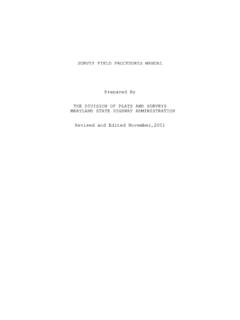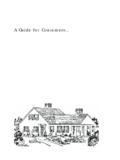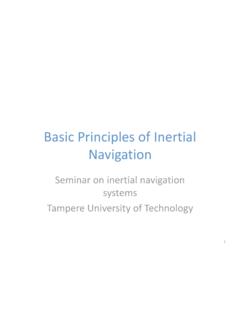Transcription of Two-Peg Test: Method for checking and recalibrating a ...
1 Two-Peg Test: Method for checking and recalibrating a level or transit This Method is either for an optical or digital level, or a transit being used as a level. If this error is corrected with a transit, it also improves the accuracy of its vertical angle readings. The Two-Peg test is very simple, but provides a way to test the accuracy of a level, and if you know which screw to turn (for analog instruments) or menu to follow (for the digital level), you can adjust it to remove the error. See specific instrument instructions for making adjustments. The basic principle is that since the error in level readings results from the instrument not sighting exactly horizontally, is thus looking up or down at some angle, and that this angle is the same whichever way it's sighting: if you place the instrument exactly midway between two rod sightings, the vertical error reading on the rod is the same for each, thus the difference in reading between the rods will still give you an accurate elevation difference.
2 Knowing this, we can accurately determine the elevation of B relative to A above. If we then move the instrument to sight from A to B, with the instrument exactly on a reading at A, we can detect the error at that distance, and can adjust the reading to give us the true reading predicted for B. Process: 1. In reasonably level terrain, mark out two rod positions (A and B) on stable surfaces about 30 m apart, and set up the instrument exactly midway between them at C. A good place is along a sidewalk (preferably in a shaded area, or on an overcast day, to avoid optical problems from heat-derived air turbulence), using sidewalk chalk to mark your points. 2. Sight to A to get a rod reading, then to B to get a reading. Assign zero to A, and derive B as A-B. Say we get at A and at B, the elevation at B is (It doesn't matter what the elevation above sea level is we only need what its elevation is relative to A.) 3. Move the instrument to ~3m from position A, and get a new reading to A.
3 Subtract the elevation at B ( ) to get the foresight you should expect to get. Say your reading at A is : FScomputed = = 4. Now sight to B to get a reading, and compare it to the expected reading. A B C D A B 15 m 15 m Computed FSActual FS 5. If there's an error, your FSactual will be different from this, and requires an adjustment. Your task is to move it up or down until you get the computed FS. For analog instruments, you can adjust the cross hairs by (a) loosening the top capstan screw that allows it to move up, or the bottom capstan screw that allows it to move down; then (b) tightening to other capstan screw. Think of the capstan screws as two ends of a continuously adjusting screw you're pulling (loosening) with one and simultaneously pushing (tightening) with the other. The capstan screws are turned with adjustment tools (or drill bits, if the tools are missing) that are inserted in the side of the capstan so you can turn the screw tiny amounts.
4 For the Sokkisha level, the capstans are just behind the eyepiece, and can be exposed by unscrewing the cover that is slightly larger than the eyepiece. For digital instruments, you select things from menus, while you go through the process. You'll need to look this up. The following is from the Leica Sprinter manual: 1. With the level set up at the midpoint (C), activate the "Check and Adjust" program by pressing MENU-ADJUSTMENT. Should display cryptic instructions like "ADJUST (1/4)" with an arrow labeled MEAS pointing back to the rod. 2. Aim at the Rod at A and press the MEAS key. Measurement display, press ENTER key to accept/confirm. 3. Aim at B and press MEAS (step 2/4). The measurement displays; press ENTER to accept/confirm. 4. Shift the Sprinter towards rod A, about 3 m away and make a reading to B again (this is not the order we did things above); this will be adjustment reading 3/4. 5. Aim at rod A and press MEAS (4/4). The measurement displays; press ENTER to accept/confirm.
5 The new "collimation error" is displayed in seconds of angle and corresponding dH vertical error in mm at that distance. To accept the correction, press the ENTER key. The manual then says: "If the reticle adjustment is required, reverse the staff B for the E scale bar reading then adjust the reticle using the tool provided by following through the given instructions. In the event where warning message "Invalid Measurement" is displayed for any adjustment measurement, carry on measuring until a successful measurement is obtained (Presumably instrument is set up correctly and external conditions are conducive) and press ENTER key to accept the measurement. "To quit the Adjustment program (when the measurement is invalid) by pressing ESC key; press ESC key once, the display will go to last Adjustment step. Press ESC key twice, the display will return to the Menu. Press ESC key thrice, the display will exit to the default measuring mode." It's probably a good idea to try this again to see if the adjustment worked.
6







